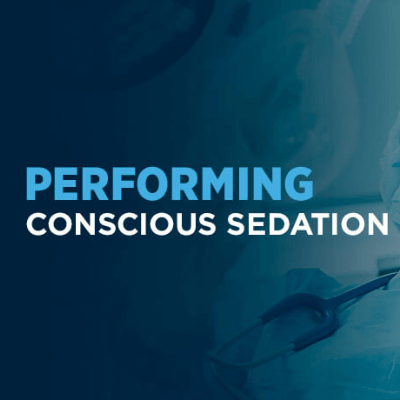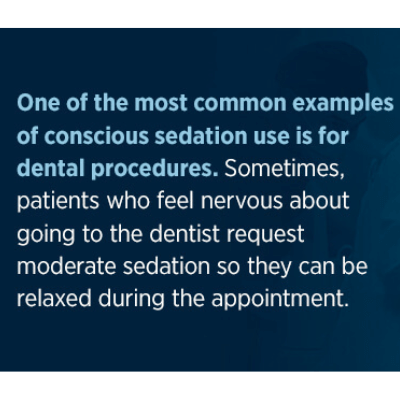
What is Conscious Sedation and How is It Performed?
Gallagher Healthcare :: Industry Insights
By Gallagher Healthcare | 9/7/2022
Performing Conscious Sedation
In some cases, patients undergoing various medical procedures require a sedative medication that isn't as strong as general anesthesia. This medication option is referred to as conscious or moderate sedation. This option means patients won't have to experience pain or anxiety about more minor procedures when general anesthesia isn't available.
Let's take a look at more information on conscious sedation and how medical professionals perform it.
What Is Conscious Sedation?
This form of sedation helps patients relax and feel no pain during specific procedures. When under conscious sedation, patients typically remain awake, though they may not be able to speak.
There are four ways to administer conscious sedation medication:
- Intravenous: An IV line in an arm vein containing a form of benzodiazepine.
- Oral: An oral tablet of diazepam or triazolam.
- Intramuscular: A shot of benzodiazepine into a muscle.
- Inhalation: Nitrus oxide via a facial mask.
Depending on the means of administration, it may take 30-60 minutes for the patient to feel the medication's effects.
Conscious Sedation vs. General Anesthesia
The main difference between moderate sedation and general anesthesia is the dosage, which affects whether or not patients go unconscious.
Under conscious sedation, patients won't become unconscious during the procedure. Instead, they remain awake — they've just been sedated to the point where they can't feel anxiety and pain. Compared to general anesthesia, moderate sedation is safer and wears off quickly, so patients can get back to normal activities after the procedure.
Those under general anesthesia will go unconscious for the duration of the procedure. This level of sedation is necessary for more intensive, lengthy surgeries like cesarean sections. As a result, general anesthesia comes with more risks and takes longer to recover from after the procedure.

Situations When Moderate Sedation Is Used
Because moderate sedation wears off quickly, medical professionals only administer it for short procedures with minimal risks. When it comes to longer, more intensive procedures, they will use general anesthesia.
One of the most common examples of conscious sedation use is for dental procedures. Sometimes, patients who feel nervous about going to the dentist request moderate sedation so they can be relaxed during the appointment. Some people refer to moderate anesthesia as "sleep dentistry" for that very reason.
A few other examples of procedures that use conscious sedation include colonoscopies, tissue biopsies and endoscopies.
The Risks of Moderate Sedation
Some of the side effects of moderate sedation include the following, which can affect patients in different ways:
- Low blood pressure
- Memory loss (of what occured during the procedure)
- Drowsiness
- Headache
- Nausea
When examined alongside general anesthesia, it's noted that moderate sedation comes with fewer risks because of the dosage. Most people will return to normal activities soon after the procedure. So long as a medical professional administers the medication and monitors the patient accordingly, they're unlikely to experience severe risks.
How to Safely Perform Moderate Sedation
Here are several of the steps required to appropriately and successfully perform moderate sedation:
1. Keep Licensure Up-to-Date
Before administering conscious anesthesia to patients, ensure you're complying with all federal, state and local regulations. Additionally, obtain the necessary licensing and accreditation to make sure you're remaining compliant. This step is important in general, but it's one of the conscious sedation protocols that will keep your practice protected financially and legally.
2. Thoroughly Evaluate Patients
On an individual basis, always evaluate patients prior to offering moderate sedation as an option. This is a crucial step to ensure the patient has the right medical and procedure history for the safe administration of conscious sedation.
Check their medical and procedure records to see any conditions or procedures that make them unsuitable health-wise for conscious sedation. Additionally, note allergies and medications that may interfere with the process. Perform a physical evaluation to ensure the patient is in good health, as well.
Right before the procedure happens, complete another physical evaluation — a preprocedure examination — to double-check the patient's vitals and that they followed NPO — no eating or drinking — guidelines.
3. Obtain Written Informed Consent
Provide the patient with information about conscious sedation, including its benefits, potential side effects and administration method. When the patient is ready, have them sign an informed consent form before proceeding with the procedure. Keep the informed consent form with the rest of their medical documents.
Additionally, give the patient thorough instructions on what to do before and after the procedure. Using conscious sedation requires the patient to follow NPO guidelines. Further, the patient shouldn't consume alcohol, operate machinery or sign legal documents for 24 hours after the procedure.
4. Have Ample Staff to Assist
Consider the procedure and how many staff you'll need to complete it safely and properly.
Generally, you and another medical professional will complete the procedure. One other medical professional will monitor the patient and take immediate action should something happen. This person should be able to offer airway management support or notify someone who can if an issue arises.
Before you begin the procedure, it helps to have a brief with all of the involved staff and the patient to make sure everyone understands the goals and process of the procedure.
5. Closely Monitor the Patient
Throughout the procedure, make sure to use equipment to monitor the patient's vitals accordingly, including ventilatory function, oxygenation, blood pressure, heart rate and consciousness. Check that every machine's monitor alarm is turned on and audible so that no one in the room misses an alert. This part of the procedure will be a dedicated staff member's responsibility so the patient receives the proper amount of attention.
6. Prepare for an Emergency
Of course, it's crucial to ensure you and your team are prepared in case of an emergency. Have the proper equipment and medications readily available. See that everyone in your office is adequately trained on emergency procedures so each person knows what to do. Ensure all staff members have their own emergency assignments, such as calling 911, to take action immediately and properly.
7. Set Aside Time for Post Care
When you've successfully completed the procedure, give yourself and your staff at least 30 minutes to monitor the patient. If the patient feels a side effect such as dizziness or nausea, treat the issue. Once the patient is prepared to leave the office with the help of a responsible adult, make sure they have the proper postprocedure instructions.

Request a Quote From Gallagher Healthcare Today
Arthur J. Gallagher & Co. is a medical malpractice insurance company that has a proven track record of success working alongside medical professionals just like you. Let us eliminate the burden of enacting a medical malpractice program by providing an explanation of every option that's available. The professional team at Gallagher manages claims, financial exposure and other key elements of medical malpractice insurance to ensure your practice has financial peace of mind.
Contact us or request a quote from Gallagher Healthcare today!